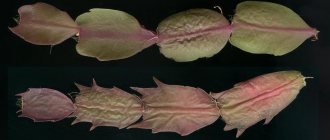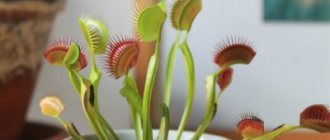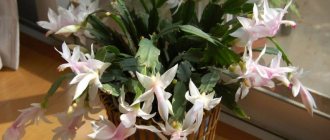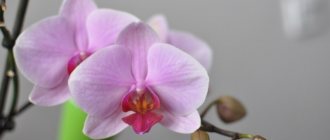Among succulents grown indoors, a prominent place belongs to the charming and unpretentious Decembrist. Its ability to bloom during the sun-deprived winter period has won the love of gardeners in the northern hemisphere.
And the decorative appearance and variety of varieties are additional incentives for lovers of tropical flora to purchase this flower for their collection.
Flower Decembrist: description
The natural habitats of the Decembrist are the high mountain forests of Brazil, from where this cactus was brought to the countries of the Old World a little more than two hundred years ago.
Interesting! The synonymous series of scientific names of the genus Decembrist consists of several positions: Schlumbergera, Epiphyllanthus, Zygocactus, Epiphyllum, Zygocereus.
In addition, the cactus bears names associated with the period of its flowering: Christmas, Decembrina. All Dekabrist varieties have a number of common characteristics:
- these are perennial plants that in nature lead an epiphytic lifestyle, but at home they grow as potted crops;
- cacti - low bushes (about 1 meter) with strong branching and abundant flowering;
- flat stems have a soft structure and consist of many joints decorated with denticles or notches;
- the insignificant and vulnerable root system is located superficially;
- no thorns;
- the color of the tubular flowers varies from white to lilac , including all shades of red-pink;
- Flowering occurs from November to February and is characterized by prolonged opening of the buds.
Decembrist can be confused with its distant relative Ripsalidopsis. But upon closer examination, Schlumbergera and Ripsalidopsis are noticeable.
In Decembrist, the stem segments have a pronounced jagged edge, the corollas of the flowers are asymmetrical; The articulations of Ripsalidopsis are almost smooth, the flower petals are of the same length and pointed. But the main difference is in the timing of flowering: Decembrist forms buds at the beginning of winter, and its relative - in the spring, closer to Easter.
3.Varieties:
3.1.Schlumbergera truncated - Schlumbergera truncatus
Epiphytic, less often lithophilic forest cacti, growing in the warm and humid jungles of Brazil. The stems are flat, branched, with oblong-oval segments, dark green, glossy. The segments have large teeth along the edges. The ends of the stems are cut off - truncated, each segment is about 5 cm long and about 2.5 cm wide. The stems are flexible, so the plants look gorgeous when grown as hanging pots - when mixed in a beautiful cascade over the edges of the pots. During the flowering period, bright flowers of pink, lavender, red, yellow or orange appear at the ends of the shoots.
↑ Up,
3.2. Schlumbergera Bucklei
An epiphytic cactus with long stems reaching a length of 30 to 60 cm. The stems consist of flat or triangular in cross-section, glossy, green, oblong-oval segments up to 7 cm long and about 2 - 3 cm wide. There are small segments along the edges of the segments. thorns. The flowers are formed at the tops of the stems, have petals of bright colors - pink, red, and reach a diameter of 3 cm.
↑ Up,
Schlumbergera corolla colors
Decembrist, as a representative of the bright Brazilian flora, stands out for the variety of colors and intensity of the color of its buds. Flowers of natural species found in indoor culture are distinguished by a rich red hue.
Specimens of Schlumbergera varieties shine with tints of pink, red and cream colors. Among the variety of varieties you can find white Decembrist, as well as plants with yellowish and two-color buds. As an exception, there are Decembrists with orange and even purple shades of corollas.
Classic varieties of Christmas
Decembrist or Christmas tree is a popular plant not only among flower growers, but also among breeders. However, everything is interconnected here: there is demand - there is also supply. And since the Christmas tree is so loved by fans of home floriculture, there are more and more varieties of this plant every year. The breeders have done their best: below you can learn about the most outstanding varieties of Schlumbergera, which captivate at first sight and turn the zygocactus into the pride and highlight of the home interior.
Schlumberger Gertner
“Gertnera” is one of the most common types of Christmas tree, which is represented by a wide variety of varieties. The color of the inflorescence, by the way, directly depends on the variety you choose. But most often, the Decembrist of this variety blooms with multi-tiered bright red flowers. A distinctive feature of the species is the large segments of the cactus, which sometimes reach seven centimeters in length.
Schlumberger Rousselian
“Rousseliana” has a slightly drooping appearance. Its branches fall from a flowerpot or pot. And at the same time they are quite long: each branch of the “Rousseliana” species can reach almost a meter in length. The cactus segments are a rich, dark green color and, when viewed from a distance, strongly resemble a traditional leaf blade. A distinctive feature of the species is its large flowers, which, like the “Gertner” species, are multi-tiered. The color of the inflorescences also depends on the variety. But more often it is either white or scarlet.
Schlumberger Barkley
“Barkley” is one of the breeders’ victories. In this species, the segments do not droop, but on the contrary, they practically stretch towards the sun. The height of the Decembrist species “Barkley” can reach 0.8 meters. Moreover, each segment of the cactus is glossy and quite dense to the touch. This species compares favorably with its fellows.
Flowers are also a distinctive characteristic feature of the species. They have a tubular structure and several tiers. The length of each inflorescence can reach ten centimeters. The color of the inflorescences can vary significantly from variety to variety. but most often the flowers have:
- white;
- hot pink;
- violet;
- yellow colors.
The flowering of Decembrists, which belong to the “Barkley” species, starts at the end of autumn and, under favorable conditions, continues until the arrival of spring.
Schlumberger Truncata, or truncated
Truncata is a type of truncated zygocactus, the segments of which are colored bright green. Breeders have managed to develop varieties whose flowers have an unusual combined color. For example, white-pink or white-yellow. A distinctive feature of the “Trunkata” species from all others is the presence of miniature berries that appear on the Christmas tree when it completes its flowering.
Popular types and varieties of Zygocactus
In indoor culture, according to GRIN - Genetic Resources Information Network, gardeners breed 9 main species of Schlumbergera. These species are the basis for the breeding work of cactus growers all over the world; on their basis, a large number of varieties and hybrids of Zygocactus have been created. Research by specialists is ongoing, thanks to which new varieties of this sought-after plant continue to be registered every year.
Photos help to identify some features of the main varieties of Decembrist.
Buckley
The most common Dekabrist variety, characterized by an increased ability to adapt to care and special resistance to diseases and pests. Can be grown as a hanging plant.
The cactus grows up to half a meter in height, has soft segments of stems of a dark shade of green, which become coarser at the base as the plant matures. The flowers are large, tubular in structure, painted in different tones of pink and lilac.
Schlumbergera Buckley has a long flowering period: from late autumn to March.
Schlumberger truncated
This variety is one of the basic ones for breeding. The height of the plant does not exceed 0.5 m. Both erect and hanging forms are cultivated.
Decabrina is distinguished by small light segments with sharp notches along the contour. The flowers are large, with curved petals, painted in various shades of crimson, less often in other tones.
Kautsky
The Decembrist variety, reminiscent of Sh. truncated - at one time these varieties were considered related subspecies. But due to its smaller dimensions, Kautsky’s Decembrist has been relegated to the category of an independent species.
It is distinguished by the purple tonality of its buds.
Microcylindrical
This succulent is distinguished by the cylindrical shape of all segments. The color of the buds varies from white to lilac shades.
The plant begins flowering in March.
Rousseliana
A low variety of Decembrist (about 30 cm), which is capable of growing long, almost meter-long, creeping stems. It is characterized by increased resistance to adverse conditions.
The plant blooms from February to April, producing many pink buds.
Orsichiana
A peculiarity is the color of the corolla petals with a noticeable color transition from reddish at the edges to white-pink in the center .
Able to form buds 3 times a year: March – August – November.
Opuntia
The succulent belongs to a variety rarely found in collections. A characteristic feature is the presence of white areoles with long spines, due to which the Decembrist segments resemble the stems of Opuntia.
The stems can reach more than a meter in length. It blooms in spring with large corollas of pink-violet shades.
The distinctive features of Decembrist varieties and hybrids can be seen in the photographs below.
Christmas fantasy
Gertner
Pasadena
Golden cream
Lavender doll
Aspen
Windsor
Mix
Lavender fantasy
Christmas flame
Sanibel
Kris Kringle
Malissa
Santa Cruz
Christmas mood
Twilight tangerine
Cambridge
Bridgeport
Golden fever
Peach parfait
Dark Eve
Madame Butterfly
White Christmas
Description of cacti of the genus Schlumberger
Epiphytic cacti of this genus are native to South America. The habitat is located in the coastal mountains of southeastern Brazil. These plants grow on trees or rocks in tropical forests.
Why does this cactus have so many names? Let's figure it out. Folk names for these cacti were given depending on the season of their flowering. In the Northern Hemisphere they are called Schlumbergera, Zygocactus, Christmas cactus, Rozhdestvennik, crab cactus, Decembrist, Varvarin color (or Varvarin braid). In Brazil, this genus is called Flor de Maio (May flower) due to the fact that the flowering period in the Southern Hemisphere falls during the spring season.
Features of cactus taxonomy
The genus Schlumbergera as we know it today contains six to nine species. Charles Lemaire proposed the creation of this genus in 1858 for a plant first described as Epiphyllum russellinum. The genus name is given in honor of the French cactus collector Frederic Schlumberger, who at that time was famous for his collection of cacti. The flower Schlumbergera russelliana has become the type species of the genus. In subsequent years, a number of new species were discovered and described. The problem of merging (“unification”) and division of genera arises constantly, and Schlumberger is an example of this. For many years there has been confusion as to how the various species of many epiphytic cacti should be divided into genera. This problem also affected Schlumbergera. In 1819, Haworth discovered and described another species of cactus - Epiphyllum truncatum. In 1890, Karl Moritz Schumann created a new genus, Zygocactus, and transferred Epiphyllum truncatum to Zygocactus truncatus. Although he later placed it back into Epiphyllum, abandoning Zygocactus. Despite this, the name Zygocactus continues to be widely used in various sources and online stores. In 1953, Reid Moran placed Schlumbergera russelliana and Zygocactus truncatus in the genus Schlumbergera. Other species were added later, including those formerly classified as Epiphyllanthus, thereby forming the genus Schlumberger of six species and a number of hybrids.
Biological description of the Decembrist
In their natural habitat, Schlumbergers grow on the branches of other plants (epiphytes) and in shady areas of cliffs and rock crevices. Cacti do not have true leaves, although their round and flat stems are often considered leaves. Young plants are erect, but as they mature the stems begin to bend and become drooping.
For the most part, Zygocactus or Christmas tree is a small bush growing up to 30 cm in height and 60 cm in diameter. The hanging branches of Schlumbergera are mostly flat and green in color and can reach a length of up to 1 meter. Decembrist stems do not have needles. Branch segments of various species have more or less distinct serrations along the edges. Flowers bloom at the tips of the branches.
Photo of Decembrist or Schluberger fruits
The flowers are two-tiered, tubular up to 8 cm long, visually look like a flower within a flower. Depending on the variety, they can be peach, red, pink, purple, orange or white. This variety of colors has been achieved thanks to the development of many cultivars and hybrid varieties of Zygocactus.
These flowering cacti can live 20 to 30 years if cared for properly.
A few words about the flowering season of Schluberger or Decembrist
Different species of Zygocactus have different flowering periods: from the end of November to the end of winter, the widespread hybrid species Schlumbergera Buckley blooms, and the truncated Schlumbergera (S. truncatus) blooms from the end of December to February.
Many people do not know, but because of this difference in flowering time, these varieties are called differently: the first species is called Decembrist and the other, better known as Zygocactus truncated, is commonly called the Christmas cactus or Varvarin flower (it begins to bloom in December, closer to Varvarin day).
What is the difference between Schlumbergera and Ripsalidopsis?
Often inexperienced flower growers classify the so-called “Easter cactus” or Ripsalidopsis among the Decembrists, since they are very similar in appearance. But there are still differences between them. We described in detail the distinctive features of the Christmas cactus and the Easter cactus in our article.
There are more than 200 artificially bred varieties of Schlumbergera, which in turn once again emphasizes the great popularity of this cactus among gardeners.
Decembrist: care at home
Being a not very demanding crop in terms of cultivation, the Brazilian cactus prefers regular and attentive care, with strict adherence to all agrotechnical regimes.
Lighting and placement
Decembrist under natural conditions grows under a canopy of tree branches, so it genetically does not tolerate the long-term influence of the hot rays of the sun. Bright lighting is one of the reasons why Decembrist leaves turn red.
But without sufficient daylight, the cactus will not receive the necessary conditions for the formation of buds.
Important! The optimal location for the Decembrist is considered to be on the western and eastern windows, where suitable light activity is created and direct sunlight is excluded.
Southern window sills are also suitable, provided the plants are shaded during the summer afternoon hours. On the windows of the north side, a lack of lighting is guaranteed for the Decembrist , so additional lighting with daylight spectrum lamps should be considered. In this case, the question of how to make the plant bloom on time will be resolved.
Temperature
The thermometer readings within +17 + 22 °C are suitable for the Decembrist. This temperature must be maintained throughout the spring and summer.
As cold weather approaches, the temperature should be lowered slightly (by 2–3 degrees) to create a comfortable environment for the Decembrist to form buds. During flower blooming, such temperature indicators will increase the flowering period.
Attention! It is necessary to protect the cactus from sudden temperature changes, since drafts and hypothermia can disrupt the flowering schedule of the Decembrist. It is the violation of the temperature regime that is the main reason why the cactus does not bloom.
After the flowers fall, the plant needs a mandatory rest: it must be moved to a cool room with optimal lighting.
Soil and fertilizing requirements
The root system of the Decembrist is poorly developed, so the substrate for the plant should be selected as nutritious, light, with good aeration and water permeability.
Throughout the active growing season, Zygocactus must be fed monthly with a solution of mineral fertilizers.
Attention! It is prohibited to feed recently transplanted or sick specimens.
Watering mode
Each subsequent watering is carried out after slightly drying the upper part of the earthen substrate.
Regular and moderate soil moisture is one of the main rules on how to care for the Decembrist so that it blooms at its proper time. Drainage at the bottom of the pot is also required to protect the roots from rot.
Transfer
The Decembrist has a negative attitude towards any interference in the processes of his life. This also applies to cactus transplants. When deciding how to replant a plant, it is advisable to give preference to the transshipment method.
Young plants, due to their rapid growth and development, need to replace the pot and substrate annually. Older specimens can grow in one pot for about five years.
Advice! The health of the Decembrist root system, and therefore the well-being and decorativeness of the entire plant, depend on the presence of a drainage layer at the bottom of the flowerpot.
Trimming
For Schlumbergera, pruning is necessary. It stimulates the branching of plant stems, which promotes the formation of more buds on newly formed shoots and more luxuriant flowering.
Decembrist pruning is done after the last flower has dried: you should manually remove all the dried corollas and remove part of the young growth along the line of articulation of the stem segments.
This video shows how to prune Decembrist for lush flowering.
How to propagate the Decembrist cactus
Schlumberger is propagated by two methods - cuttings and seeds. The best time to propagate Zygocactus is one to two months after the end of flowering. You should not propagate it in autumn and winter, when it sets buds and actively blooms. The easiest way to propagate Christmas trees is from stem cuttings.
Cuttings
- First of all, prepare the container and fill it with substrate for cacti, universal soil mixture for flowering crops or sand-peat soil.
- Using a sterile knife or scissors, cut off a section of the stems with three to five segments on each.
- Place the cuttings in a cool, dry place for a couple of days until the cutting area is dry.
- Then lightly press the cuttings about 3 cm deep into the slightly moistened soil. Water the soil well. To create a moist environment and encourage rooting, cover the container with a clear plastic bag.
- Water the soil regularly and allow the soil to dry out between waterings. It takes two to three weeks for roots to form. Remove the film when the cuttings take root.
If desired, you can root the stems in water before planting them in soil. Place the cut end into 3-5 cm of filtered water and place the jar in a window with indirect light.
After a few weeks, the cuttings should produce roots at least 4 cm long and then they are transplanted into a pot.
How to grow Schlumberger from seeds
You can collect cactus seeds from the fruits of the plant. Wait until they turn pink. Fruit formation usually occurs in the fall.
Remove the dark brown seeds and wash off the pulp.
- Plant the seeds in moist soil with perlite or cactus soil mixture. Press the seed lightly into the soil without covering it, or sprinkle a thin layer of sand on top.
- Cover the pot with clear film or glass to increase the humidity in the container.
- Place the container on a lighted windowsill, but out of direct sunlight.
- Regularly spray the soil surface with water every day.
- In two to three weeks, shoots should appear. Remove the film or glass as soon as you notice the seedlings growing.
- Transplant the seedlings into individual pots when they are large enough.
Reproduction of the Decembrist flower
Obtaining young specimens of Schlumbergera is possible in two ways: by seeds and individual parts of the stem. The procedure should be carried out in the spring.
The simplest and most accessible is propagation by shoots. You should carefully break off a part of a healthy, young stem along the border of the articulation. The main thing is that the process must have at least 3 segments.
The grower himself must decide how to plant the shoot. You can root the cuttings in water and then plant them in a flowerpot, or you can dry them until a film forms and immediately place them in a substrate for rooting at the site of future growth.
Reproduction of Decembrist by seeds is a more labor-intensive process. To figure out how to grow a healthy plant from seeds, you need to take the advice of experienced cactus growers.
The first stage is obtaining a seed by cross-pollinating two flowers. The seeds will ripen in approximately 8 months.
The second stage is peeling the seeds from the fruit skin, treating them with disinfectants and planting them in a substrate without covering them with soil. To guarantee germination, you can build a mini-greenhouse.
Reproduction
Produced in several ways:
- Seeds . Germinate under film in moist soil. Germination period is from 1 to 3 months.
- By cuttings . Cuttings dried in partial shade are placed in soil and covered with film. Rooting time is 3-4 weeks.
- Grafting . The cuttings are placed on supports (cacti of another type) and secured with thread. This method requires special skills and knowledge.
Plant pests and diseases
With proper and regular care, the Decembrist is quite resistant to various diseases and parasites.
Carefully! Mistakes by gardeners in maintaining Schlumbergera weaken the plant, which can lead to disease or insect damage.
Insects dangerous to plants
Pests include spider mites, thrips and mealybugs. The affected plant must be quarantined, treated with insecticides, and errors in maintenance that caused it to weaken must be corrected.
Infections
Diseases affecting Schlumbergera are of different nature. Fungal pathogens are dangerous for the plant, the appearance of which causes late blight, cladodia rot and fusarium. There is also a bacterial disease - rot of the base of the stem.
Among the treatment methods, we can recommend the correction of care regimens, treatment with fungicides and pesticides, cuttings of a cactus in order to save it in case of severe damage.
Difficulties in care
Despite all its unpretentiousness, the Decembrist can get sick and die if kept in the wrong conditions.
Diseases and pests
Revealed upon examination. Most often the plant is affected by:
- mealyworms;
- scale insect;
- spider mites.
Symptoms of damage:
- Shield . There are brown raised spots on the leaves. The leaves wither and fly off.
- Spider mite . Rusty coating on the stem, cobwebs. The leaves are falling off.
- Mealyworms . White lumps between segments.
Pests must be removed mechanically: with a warm shower or a cotton pad moistened with a solution of laundry soap. Then treat with insecticides according to the instructions.
Shedding of leaf segments
There are several reasons for this:
- lack of nutrients;
- sudden temperature change;
- transfer;
- dry air;
- excess moisture;
- stress (moving).
- If there is a lack of nutrients, the plant is fed with fertilizer for epiphytic cacti.
- The flower is placed in a humid place, inaccessible to drafts and temperature changes.
- If there is excess moisture, stop watering.
- After suffering stress (transplantation, moving), the plant recovers itself, adapting to new conditions.
Fungal diseases
Caused by contaminated soil. Truncata becomes lethargic, loses elasticity and color, and sheds its leaves. Such diseases are treated with fungicides. The plant treated with the drug is transplanted into a new pot with new soil.
Hypothermia and overheating
- Decembrist is sensitive to the temperature of water for irrigation. If the water is cold, the root system of the flower dies, the plant loses stability, and the shoots lose their elasticity. Leaf segments acquire a brown tint. Water with warm water.
- When overheated in the sun, the root system burns ; the symptoms are the same as with hypothermia. The pot with truncata must be moved to a place protected from direct sunlight.
Preparing the Decembrist for flowering
The process of preparing the cactus for the flowering period begins in the spring. During the active growing season, the plant grows new shoots, on which buds will then appear.
You can help the plant during this period by maintaining optimal conditions - sufficient lighting, proper watering and fertilizing, ideal temperatures.
In autumn, the formation of buds begins . There will be more of them with proper pruning, going through a resting phase and lowering the temperature to optimal levels.
Advice! At a time when the Decembrist is blooming, the pot with the plant should under no circumstances be moved or simply moved from its place. This is fraught with the discarding of already formed buds.
The usual flowering time for Schlumbergera is from November to early February. The reason why the Decembrist blooms in March can be attributed to violations in its maintenance: high indoor temperatures in winter do not allow the cactus to bloom on time.
This video tells how to care for the Decembrist in summer and autumn.
Caring for the plant
Schlumberger care at home is simple. However, you cannot leave a flower “to the mercy of fate”. In nature, the plant leads an epiphytic lifestyle. It settles in trees and rocky areas. Unlike desert cacti, Schlumberger's flower prefers shade instead of bright sun and humidity instead of dry hot air, as well as more fertile soil. Among the main points to consider when caring for culture are the following:
- selection of soil, organization of fertilizing;
- irrigation scheme;
- humidity and temperature conditions;
- competent transplant.
Soil selection, fertilizing
Rose Moody Blues - basic rules for plant maintenance
It is important to know that the indoor Decembrist prefers nutritious soil. You can purchase a substrate (labeled for cacti) at a specialty store, or you can prepare it yourself. For the second option you will need:
- one part of leafy soil;
- three parts of turf;
- two parts sand mixture;
- one part of humus or compost;
- some fly ash.
It is important to prepare a soil mixture that is light and breathable. The preferred acidity level is 5-6 pH. This is acidic soil.
The indoor flower is undemanding to a large amount of fertilizing. Experienced flower growers advise carrying out 4 procedures per year. They begin to fertilize it during the period of active growth, that is, in spring and summer. Complex fertilizers for house plants are used. It is allowed to buy mixtures with a predominance of potassium and phosphorus. The plant should not be spoiled with nitrogen-containing additives. Feeding continues until autumn. During flowering, the flower should not be fertilized.
Watering
Like other cacti, Zygocactus Schlumbergera tolerates drought well. However, in order for the ornamental crop to be healthy and bloom luxuriantly, it is important to organize proper watering. The substrate in the pot is watered once every 10 days. You can also monitor the condition of the soil. As soon as the soil in the pot has dried, organize watering.
In autumn, watering is carried out once every 15-17 days. This is necessary for the plant to begin to lay flower buds.
Additional Information. Schlumberger's flower does not tolerate stagnant moisture. Frequent watering destroys the roots of the plant. Fungus appears on them.
Water the perennial once every 10 days
Humidity and temperature conditions
The plant develops well at normal air humidity (35-55%). It does not require additional humidifiers. The only thing you can do to please a perennial is irrigation with settled water. Leaf scales come to life under the influence of water drops and acquire a brighter color.
Comfortable air temperature for the Decembrist is from +16 to +25 degrees. In the summer, when the flower is actively developing, it is allowed to place it on an open balcony. But you should ensure that the difference between day and night temperatures does not exceed 10-15 degrees. In autumn, zygocactus is kept cool. A room where +17 degrees is suitable. In November, when flowering begins, Schlumbergera needs a temperature of +20...+22 degrees. After all the flowers have fallen, the pot is again put away in a cool place with a temperature of +15...+17 degrees.
Competent transplant
It is not recommended to leave the plant in a purchased pot. A couple of days after acquisition, the cactus is replanted. Schlumberger Decembrist has been in quarantine for two days. It is placed on the window away from other flowers. Another reason for replanting is the appearance of the Schlumbergera root system on the surface of the soil in the pot. This suggests that Dekabrist needs a transplant.
Note! Unlike other indoor plants, the zig cactus does not need to change its pot every year. This must be done once every 3-5 years, mainly in spring - summer. As a result, the plant tolerates no more than 4-6 transplants throughout its life.
Recommendations for transplantation:
- Replanting begins with choosing a pot. It should be stable and moderately wide.
- Next, the soil mixture is prepared.
- Drainage (clay fragments, pebbles, gravel, etc.) is poured onto the bottom. It is covered with an earthen substrate on top.
- The root system is removed from the old pot. The plant is watered first.
- The roots are inspected for rotting. If any, the rhizome is trimmed.
- Planting involves placing the rhizome in a soil mixture in a new pot. It is unacceptable to bury the instance. The foliage should not come into contact with the ground.
- The final step in replanting is watering.
A clay pot is suitable for replanting.
Signs and superstitions
All signs associated with the early flowering of Schlumbergera promise good luck and an improvement in the financial situation in the family for the entire next year.
When a cactus blooms on time for a creative person, it promises the owner new horizons in his work.
The lush bloom of a cactus is associated with a lot of positive emotions in the house. But this does not mean that the Decembrist flower is a donor or a vampire. Simply, the happier the people in the house, the more care they give to the plant. And it responds to love with abundant flowering.
The variety of Decembrist varieties allows you to choose specimens that meet the tastes of each cactus grower. And its unpretentiousness and ability to adapt make it possible to grow this plant in the collections of beginners. The main thing is to follow care regimens and treat your pets with love.
Transfer
Young bushes of Decembrist truncated are replanted annually . Adult flowers are renewed less frequently - once every 3-4 years. The pot required is shallow, wide, 2–3 cm larger in diameter than the previous one, with drainage holes.
The substrate required is light, loose, nutritious. Often, ready-made peat soil is used for replanting. You can prepare a special mixture:
- leaf soil;
- turf land;
- crushed charcoal;
- sand.
All ingredients are mixed in equal parts. Drainage is required - brick chips, pebbles.
Replanting is done after flowering . It is recommended to use the transshipment method; preserving the earthen clod prevents damage to the root, the flower takes root easier and faster.
Preparation of planting material and propagation
Schlumberger (care at home involves the ability to quickly propagate the variety you like) grows rapidly in nature, dissipating by seeds and breaking off segments. The culture is considered one of the easiest to breed. Moreover, it is faster and easier to propagate domestic Schlumbergera vegetatively.
Cuttings
This is the most common method of propagating zygocacti, in which all the characteristics of the mother plant are preserved. Schumbergera cuttings provide good survival rate at any time of the year. But it is better to carry out the operation in the spring, after flowering has ended.
Reproduction process:
- A segment with 2 or 3 segments is removed from a healthy shoot. At the same time, pinching or cutting is much less effective than simply unscrewing it by hand.
- Cuttings with rudiments of aerial roots that appear on the bush take root well. In this case, you can immediately bury the segment into the substrate, without any germination.
- For subsequent rooting, air-dried segments are used. To do this, they are kept for at least 2 days at room temperature, spread out on paper.
- Then the cuttings are stuck vertically into a moist, nutritious substrate to a depth of no more than 5 mm.
- Covering the plantings when setting up a greenhouse should only be done as a last resort if the segments have begun to dry out and become wrinkled. Typically, Schlumbergera takes root within 30 days without shelter.
When rooting in water, you should carefully monitor both the water level and its condition. If the liquid becomes cloudy, replace it immediately. Fleshy Schlumbergera often rots faster than it can develop viable roots.
Vaccination
A painstaking method to obtain flowering branches of Schlumbergera on other deciduous cacti. For rootstock, prickly pear, pereskiopsis or pereskia are often used. When properly formed, spectacular standard trees with beautiful flowering are obtained.
Prickly pear grafting process:
- Prepare the upper part of the rootstock by removing the leaf buds. A small vertical incision about 1 cm deep is made.
- Unscrew a shoot with three segments from an adult Schlumbergera plant.
- Insert the cutting into the cut with the pointed part.
- The grafting site is secured with a tape (thread, plaster, bandage).
- The bandage is removed only after growth appears on the cutting.
- Place a plastic bag over the shoot containing the graft.
During the entire period of establishment, the Schlumbergera plant is kept in partial shade at a temperature of +18 °C. All emerging lateral growth should be removed from the rootstock. The usual time for grafting to take root is 3 weeks.
Seeds
This method of propagation is used by professionals to obtain hybrids with unusual colors. Since the plant does not have the ability to self-pollinate, the process must be done manually.
The process of obtaining seeds at home:
- The long pistil of one flowering Schlumbergera should be dipped in pollen from the stamens of another.
- If pollination is successful, a thickening ovary will appear in a few days.
- After 30 days, the ovary will turn into a pink berry.
- Seeds ripen on average in 6 months.
- The reddened and softened berry is removed from the bush.
- Remove the seeds, wash and store until planting for at least 12 months in a dry, dark place.
Schlumbergera is sown by the end of March in moist sandy soil. The seeds are only slightly pressed into the substrate, and then the plantings are covered with polyethylene for a greenhouse effect. Germination requires regular aeration and spray watering.
Seedlings need good lighting and regular spraying. Seedlings are picked at the age of 2 months. Flowering begins only in the 2nd–3rd season, and the Schlumbergera bush will acquire its typical size in 4 years.
Landing algorithm
Rooted cuttings are planted in separate pots only when they are fully established and new growth appears. Store-bought plants should be transplanted into a new container a few days after purchase. The plant must adapt to new conditions. But you shouldn’t delay planting either - the substrate for transportation is not intended for full development.
Planting process:
- Drainage materials are poured into the pot in a layer of about ¼ of the total volume.
- Fill the container with soil, not reaching 1 cm to the edge.
- Make a hole in the center according to the size of the seedling's root system. Usually this is a very small depression.
- Place the plant with its roots in the hole. Sprinkle the missing soil and squeeze lightly.
- Carefully water under the root using a watering can with a long spout.
To obtain a harmonious, beautiful bush, several cuttings are usually planted in a circle in one pot. Particularly effective compositions are obtained when using varieties with different flower colors.











